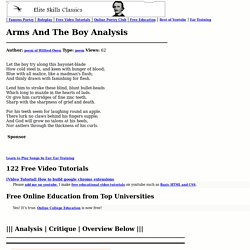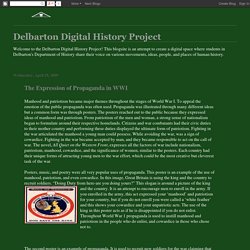

Documentos de Google: crea y edita documentos online de forma gratuita. Siegfried Sassoon and poets of the Great War. Secrets of the Manor House - Part 1/4. Poets of World War I - Part One - Harold Bloom - Google Books. Reframing First World War poetry. Dr Santanu Das considers how the examination of war poetry has changed and looks beyond typical British trench lyric to explore the variety of poetic responses.

Dr Santanu Das gives an introduction to the poetry of the First World War, providing fascinating commentary on a range of topics, supported by literary manuscripts and historical footage. In some papers found in his kit after his death in the Battle of Loos on 13 October 1915, the twenty-year-old Charles Hamilton Sorley had scribbled in pencil what would become one of the most celebrated sonnets of the First World War: When you see millions of the mouthless dead Across your dreams in pale battalions go, Say not soft things as other men have said, That you’ll remember. For you need not so. Give them not praise. Repeatedly anthologised, yet forever startling. Arms And The Boy Analysis Wilfred Owen : Summary Explanation Meaning Overview Essay Writing Critique Peer Review Literary Criticism Synopsis Online Education. | Famous Poetry | Roleplay | Free Video Tutorials | Online Poetry Club | Free Education | Best of Youtube | Ear Training <p>Analysis, Summary, overview, explanation, meaning, description, of Arms And The Boy online education</p> Author: poem of Wilfred Owen Type: poem Views: 62 Let the boy try along this bayonet-blade How cold steel is, and keen with hunger of blood; Blue with all malice, like a madman's flash; And thinly drawn with famishing for flesh.

Lend him to stroke these blind, blunt bullet-heads Which long to muzzle in the hearts of lads. Or give him cartridges of fine zinc teeth, Sharp with the sharpness of grief and death. For his teeth seem for laughing round an apple. Sponsor Learn to Play Songs by Ear: Ear Training 122 Free Video Tutorials [Video Tutorial] How to build google chrome extensions Please add me on youtube. Free Online Education from Top Universities. Propaganda World War One. Delbarton Digital History Project: The Expression of Propaganda in WWI. Manhood and patriotism became major themes throughout the stages of World War I.

To appeal the emotion of the public propaganda was often used. Propaganda was illustrated through many different ideas but a common form was through posters. The posters reached out to the public because they expressed ideas of manhood and patriotism. From patriotism of the men and woman, a strong sense of nationalism began to formulate around their respective homelands. Citizens and war combatants had their civic duties to their mother country and performing these duties displayed the ultimate form of patriotism.
Posters, music, and poetry were all very popular uses of propaganda. . The second poster is an example of propaganda. Diers means peace quicker. Throughout World War 1, women were used as nurses, factory workers, and some even as soldiers. En even took control of the men’s jobs. Each image relates to the novel, All Quiet on the Western Front, in many different ways. . Propaganda for patriotism and nationalism. Professor David Welch explores nations’ reliance on propaganda in World War One, with a focus on symbols and slogans of nationhood and patriotism.

Professor Jo Fox provides fascinating insights into propaganda techniques of World War One. The First World War was the first war in which the mass media played a significant part in disseminating news from the Fighting Front to the Home Front. It was also the first war to target systematically produced government propaganda at the general public. All the belligerents were therefore compelled to recognise that they had to justify the righteousness of the war and, to this end, themes such as patriotism and nationalism played an important role. ‘Your Country Needs YOU’ The armies of continental Europe were made up of conscripts, who really had little choice about going to war.
Symbols of nationhood One tactic at a state’s disposal was the use of iconic figures to strengthen a particular point about national identity in order to promote patriotism. Did World War One and British government propaganda affect the culture of publishing during the War? No Man's Land: Combat and Identity in World War 1 - Eric J. Leed. The Poetry of Shell Shock: Wartime Trauma and Healing in Wilfred Owen, Ivor ... - Daniel Hipp.